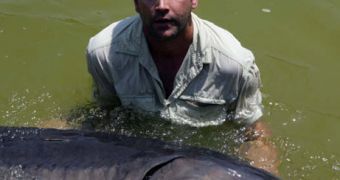When this fish appeared, dinosaurs still roamed the Earth. "Panda under the water" is the nickname of the Chinese sturgeon, a giant fish considered a "living fossil." Now they face the faith of the dinosaurs: extinction. But not from a meteorite, but from humans.
These sturgeons can grow up to 4 m (13 ft) in length and weigh 1,000 pounds (450 kg), feeding on the East China Sea and migrating into the Yangtze River to spawn.
But the Yangtze's contamination and increased shipping traffic is dwindling the populations of this giant fish: 30 years ago 2,000 sturgeons spawned in the Yangtze River annually; now, just several hundred.
"There may be only a thousand of the animals left in the river," said Wei Qiwei, a lead researcher at the Yangtze River Fisheries Research Institute in Jingzhou.
Wei's team is attempting to breed sturgeons in captivity and release them back into the river, in an effort to save the species. The breeding base is located into a surrounding outside Jingzhou. The hatchery facility, the size of two football fields, harbors numerous rows of tanks with sturgeons in varying degrees of development, from hatchlings to one-year-old fish.
Sex cells are cropped from sexually mature sturgeons taken from the wild.
"The short-term goal is to preserve the fish in captivity, but the long-term goal is to preserve the fish in the river as part of the ecosystem," Wei said.
The sturgeons are kept in captivity until they are sexually mature and then released into the wild. But sturgeons are slow breeders: a Chinese sturgeon reaches sexual maturity in 10 years. That's why the oldest of those obtained here, kept in outside tanks, need at least another 5 years to mature.
"The critical issue for us is to make brood stock [from the fish taken from the wild] and then to release them again. But we have not come full circle yet, so we don't know if this will be possible." said Zeng Lingbing, director of the institute's Fish Pathology Laboratory.
"This breeding program is like an insurance policy to make sure this ancient fish does not disappear," said biologist Zeb Hogan, head of the National Geographic Society's Megafishes Project, a three-year program to document the world's largest freshwater fishes.
"The fish can grow up to 4 m, but no sturgeons that big have been seen in the Yangtze in the past 20 years," Wei explained. The Chinese sturgeon effectuated the longest migration of any sturgeon species, once over 2,000 miles (3,500 kilometers) up the Yangtze. But the Ghezouba Dam, built in the early 1980s, cut off this migratory path, both for the sturgeon and for the much more critically endangered Chinese paddlefish, an even larger sturgeon-related fish.
"All of the sturgeon's original spawning grounds were located upstream from the dam. There used to be spawning grounds totaling more than 600 kilometers [375 miles] in the river. Now there is less than 30 kilometers [19 miles]." said Wei.
Increased boat traffic on the Yangtze is a huge peril to the sturgeon, which frequently moves near the surface: annually about 10 individuals die due to collision with boat propellers. The sturgeon is also extremely sensitive to noise contamination provoked by the intense traffic. And contamination has come with an unpredicted issue.
"Worsening water contamination from industrial runoff and other sources may be causing sturgeons to change their sex. After 1995 the ratio of male to female has totally changed. It used to be one to one, but now there may be up to ten females for every one male." said Wei.
Wei is also attempting to create artificial spawning grounds in the Yangtze River. Otherwise, releasing the artificially bred individuals would be in vain.
Two other giants of the Yangtze river, the paddlefish and baiji (the Chinese river dolphin) are now threatened with extinction.

 14 DAY TRIAL //
14 DAY TRIAL //